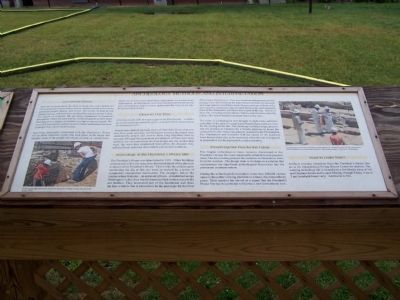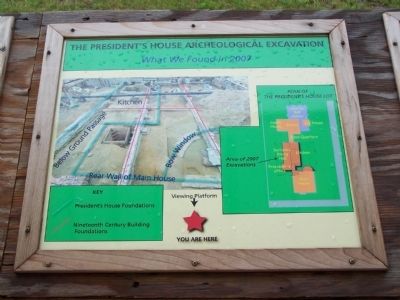William Penn Annex East in Philadelphia in Philadelphia County, Pennsylvania — The American Northeast (Mid-Atlantic)
Archeology Methods and Interpretation
How do we learn about the lives of those who came before us? Old documents such as letters, diaries, and land deeds tell us about particular people, places and events. Yet written records do not always survive and most were produced by and for society's elite. The details of everyday life are rarely mentioned in historical documents. Ofter the poor and the enslaved appear as little more than figures in a ledger of numbers in a tax or census record. We must look beyond the written record to better understand the lives of people from all levels of society.
Surviving documents associated with the President's House tell us about important events that took place in the house and identify some of the people who lived, worked, or visited there. However, to learn more about these individuals, we needed more information. In studying the excavated artifacts left behind on this site, archeologists hope to better understand the lives of all who lived and labored here.
Clues to Our Past
A sewing needle falls through a gap in the floorboards...a child's toy is lost and forgotten in the yard...a broken dish is tossed down an abandoned well...
People leave behind physical traces of their daily lives wherever they live, work, and play. Archeologists examine the places once inhabited by people and recover these long-forgotten clues to our past. Though the excavation and analysis of these recovered artifacts, we can learn about the food people ate, the clothes they wore, and ways they entertained themselves, the diseases they suffered from, and even their beliefs and cultural traditions.
Archeology at the President's House Site
The President's House was demolished in 1832. Other buildings constructed on this site since then destroyed much of the physical evidence of the President's House. That is why the archeologists conducting the dig at this site were so excited by a series of completely unexpected discoveries. For example, below the kitchen where Hercules - an enslaved African - presided as George Washington's chef, they found a basement that written records did not mention. They uncovered part of the foundation was from the bow window that is believed to be the prototype for the Oval Office in the White House. They also found an underground service passage from the kitchen to the main house that both the enslaved and wage earners would have used. Deeper portions of three wells and one privy (outhouse) also escaped destruction, and contained most of the thousands of artifacts discovered at the site. Debris of daily life, including broken dishes, bottles, animal bones, and clay pipes, offer archeologists important clues to the past.
The team of archeologists
that brought to light these authentic reminders of the nation's complicated beginnings hosted an event for the closing of the site. The ceremony included songs, prayers, and the pouring of libations by a Yoruba priestess to honor the enslaved Africans. Nine brass plaques donated by the Philadelphia Fire Department and inscribed with the names of the enslaved were buried at the site to be recovered when the site is reopened in preparation for the permanent commemoration.
Preserving Our Past for the Future
The fragile archeological ruins recently discovered at the President's House Site were temporarily reburied to help preserve them. The dirt covering protects the centuries-old foundation walls from the weather. The design team is working on a solution that incorporates the significant archeological discoveries into the permanent commemoration.
During the archeological excavation, more than 300,000 visitors came to the public viewing platform to witness this extraordinary place. Their reaction has served as a signal that the President's House Site has the potential to become a new international icon.
Want to Learn More?
Artifacts recently unearthed from the President's House Site are at the Independence Living History Center for analysis. The working archeology lab is located just a few blocks away at 3rd and Chestnut Streets and is open Monday through Friday, 9am to 5pm (weekend hours vary). Admission is free.
Topics and series. This historical marker is listed in these topic lists: African Americans • Landmarks • Notable Buildings • Notable Places • Science & Medicine. In addition, it is included in the Former U.S. Presidents: #01 George Washington series list. A significant historical year for this entry is 1832.
Location. 39° 57.029′ N, 75° 9.01′ W. Marker is in Philadelphia, Pennsylvania, in Philadelphia County. It is in William Penn Annex East. Marker is at the intersection of Market Street and 6th Street, on the left when traveling west on Market Street. Touch for map. Marker is at or near this postal address: 101 Market St, Philadelphia PA 19106, United States of America. Touch for directions.
Other nearby markers. At least 8 other markers are within walking distance of this marker. The President's House Site 1790-1800 (here, next to this marker); The President's House - Washington and Adams (here, next to this marker); Enslaved Africans in the Household of George and Martha Washington (here, next to this marker); Chef Hercules (here, next to this marker); Contagion and Liberty (here, next to this marker); Mount Vernon to Philadelphia (here, next to this marker); Strengthening Ties with the United States (here, next to this marker); Oney Escapes! (a few steps from this marker). Touch for a list and map of all markers in Philadelphia.
Regarding Archeology Methods and Interpretation. Left Photo - Archeologists make unexpected discoveries during the President's House Site dig in the spring of 2007.
Right Photo - Representatives of the local community recently gathered to temporarily rebury the site and honor the enslaved Africans who worked and toiled here. Photographs courtesy of the City of Philadelphia.
Credits. This page was last revised on February 2, 2023. It was originally submitted on July 8, 2008, by Bill Pfingsten of Bel Air, Maryland. This page has been viewed 1,194 times since then and 15 times this year. Photos: 1, 2. submitted on July 8, 2008, by Bill Pfingsten of Bel Air, Maryland.

